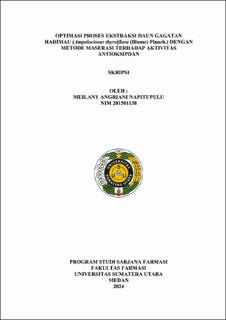| dc.description.abstract | Gagatan harimau leaf (Ampelocissus thyrsiflora (Blume) Planch.) was recognized for its natural antioxidant properties. Traditionally, it was used to treat diarrhea, as a tonic, and for healing wounds, infections, and diabetes.The aim of this study was to determine the optimum solvent-to-material ratio and extraction time in ethanol extraction of gagatan harimau leaves using the maceration method, which results in very strong antioxidant activity. This study employed an experimental approach, beginning with extraction using maceration. The extraction was conducted with varying solvent-to-sample ratios (1:8, 1:10, and 1:12) and extraction times (6, 12, and 24 hours). Antioxidant activity was tested using the DPPH (2,2-diphenyl-1-picrylhydrazyl) free radical scavenging method, measured by visible spectrophotometry at 516 nm.Th results are the highest yield (15.56%) was obtained at a solvent ratio of 1:12 for 24 hours. Phytochemical screening revealed the presence of alkaloids, flavonoids, glycosides, steroids/triterpenoids, saponins, and tannins in the ethanol extract. The IC50 value for DPPH radical scavenging of the ethanol extract was 20.26 ± 1.63 μg/ml at a ratio of 1:10 for 24 hours, while the minimum IC50 was 29.93 ± 0.02 μg/ml at a ratio of 1:8 for 6 hours, both categorized as very strong. Quercetin, used as a standard, showed an IC50 of 3.21 ± 0.14 μg/ml, also categorized as very strong.
Conclusion: Based on the results of the study, the optimum extraction conditions for achieving the best antioxidant activity are obtained at a solvent ratio of 1:10 and extraction time of 24 hours. | en_US |


